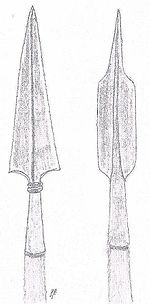Ox tongue (polearm)
| Ox tongue (polearm) | |
|---|---|

|
|
| Information | |
| Weapon type: | Lance, polearm |
| Designations: | Ox tongue, chisel, langue de boeuf, ox tongue |
| Use: | weapon |
| Working time: | around 16th century |
| Region of origin / author: |
Europe , military |
| Distribution: | Europe |
| Overall length: | about 200 cm |
| Handle: | Wood |
| Lists on the subject | |
The ox tongue (also chisel , French: Langue de Boeuf , English: Ox Tongue ) is a pole weapon from Europe.
description
The ox tongue usually has a straight, double-edged blade. There are different versions that differ in blade length, width and shape. There are blades with a central ridge or with a hollow grind. They are attached to the shaft with the help of a grommet. The name ox tongue comes from the similarity of some blade shapes with the tongue of an ox . In use it was guided like a lance . The surfaces are often decorated with engravings and etchings . The ox tongue was used by military units in Europe.
literature
- Heinrich Otte, Archaeological Dictionary , Verlag Reprint-Verlag-Leipzig, 2001, page 381, ISBN 978-3-8262-1513-1
- Max Jähns, History of the development of the old defensive weapons: with an appendix on the firearms , Verlag ES Mittler, 1899, page 151
- JA Beil, Karl Karmarsch, Technological Dictionary of German, French and English: with reference to trade, physics, chemistry, nautical science, mining, mineralogy and other mechanical and industrial sciences, Volume 3 , Verlag CW Kreidel, 1868, page 362
Web links
Commons : Polearms - Collection of images, videos and audio files
Individual evidence
- ↑ George Cameron Stone: A glossary of the construction, decoration and use of arms and armor in all countries and in all times . Forword by Donald J. LaRocca. Dover Publications, Mineola, New York 1999, pp. 411, 412, ISBN 978-0-486-40726-5